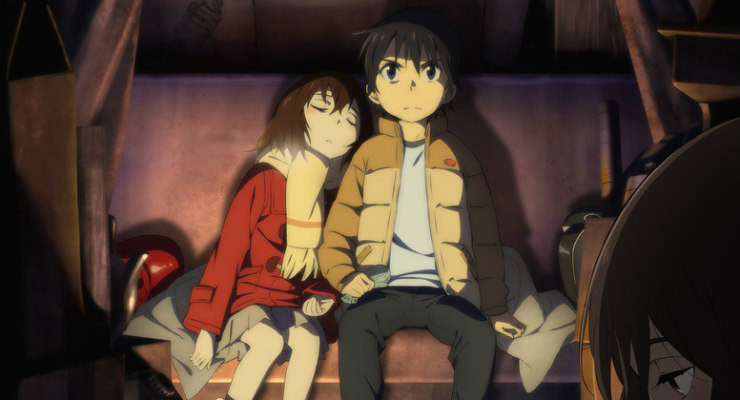Erased vs Erased
April 20, 2018 · 1 comment
By Andrew Osmond.
 The concluding half of the splendid anime time-travel thriller Erased arrives on 30th April as a Collector’s Blu-ray and a DVD. If you’ve not heard of the series before, hop over here for our introduction. If you’re an Erased fan, you’re in luck, as you can binge the story both in animation and live-action. And by live-action, we don’t mean a film, but a six-hour live-action Japanese series, available to Netflix subscribers.
The concluding half of the splendid anime time-travel thriller Erased arrives on 30th April as a Collector’s Blu-ray and a DVD. If you’ve not heard of the series before, hop over here for our introduction. If you’re an Erased fan, you’re in luck, as you can binge the story both in animation and live-action. And by live-action, we don’t mean a film, but a six-hour live-action Japanese series, available to Netflix subscribers.
Watching the two versions of Erased side by side is a fascinating stereo experience. They’re both very good, and often feel extremely similar – indeed, at times they’re in lockstep. However, the differences between the series are telling, and they do become drastically different in their respective last episodes. Of course, both Eraseds come from the same source, the acclaimed manga by Kei Sanbe. While it’s called Erased in English, its Japanese title translates to The Town Without Me, a phrase with multiple meanings by the end.
Sanbe’s strip debuted in 2012. In Japan, its last chapters came out in March 2016, coinciding with the end of the anime and the release of a live-action film, which is not the live-action version on Netflix. The film of Erased doesn’t seem to have been released in Britain or America, though you can see the trailer here. Its lead, playing the adult Satoru, was Tetsuya Fujiwara, formerly the schoolboy hero of Battle Royale, and Light in the two Death Note films in 2006.
We’ll touch on the Erased film later, but the Netflix serial is an entirely separate production. As a 12-part series, it’s much closer to the experience of watching the anime than a film could be. Actually, the live-action episodes run longer than the anime’s – 25 to 30 minutes, excluding titles – reflecting the freer formats of Netflix.
The actors are less familiar to Western viewers than their film counterparts. The adult Satoru is played by Yuki Furukawa, who was in Poison Berry in my Brain, Japan’s answer to Inside Out. Most of the other actors are unfamiliar to Westerners, though Mio Yuki, who plays Satoru’s present-day ally Airi, was in the 2015 Death Note TV series (available on Crunchyroll). She was Near in the later episodes, though the show’s re-envisionings meant she got to “play” another Death Note character as well.
 However, the really outstanding adult presence in Erased is Tomoka Kurotani as the mother Sachiko. She truly convinces as the story’s most important presence, a symbol of stalwart, everyday parental goodness. The boy who plays the child Satoru, the preteen Reo Uchikawa, is also great. He doesn’t convey the idea of a child with an adult’s mind, like Jodie Foster in Freaky Friday, but he appears both watchful and haunted, which is entirely right for the story. (Just before Erased, Uchikawa appeared in a Japanese stage musical version of Black Butler, playing young master Ciel Phantomhive.)
However, the really outstanding adult presence in Erased is Tomoka Kurotani as the mother Sachiko. She truly convinces as the story’s most important presence, a symbol of stalwart, everyday parental goodness. The boy who plays the child Satoru, the preteen Reo Uchikawa, is also great. He doesn’t convey the idea of a child with an adult’s mind, like Jodie Foster in Freaky Friday, but he appears both watchful and haunted, which is entirely right for the story. (Just before Erased, Uchikawa appeared in a Japanese stage musical version of Black Butler, playing young master Ciel Phantomhive.)
In fact, pretty much all the performers in the Netflix Erased, children and adults, are good. Yuki’s smiley, bubbly teenager Airi sometimes teeters on irksome, but that’s a criticism of her character more than the actor. It doesn’t help that Airi’s backstory – which involves her father and her thoughts on trust – is cut in the Netflix version, though it was given in the anime.
It’s an illustration of how the live-action series ploughs through the early story quicker than the anime does, even allowing for the longer live-action episodes. Part five of the Netflix series, for example, ends in the same place as part seven of the anime. Nothing big is cut, though if you’ve seen the anime, you may miss scenes like the children’s skating race and the roles played by Airi’s mother and Kayo’s gran. The reason for the brisk pace was given in the publicity for the show, which said it would adapt the Erased manga climax, which wasn’t used in the anime or film versions.
Disclosure: I haven’t read the manga, whose last chapters don’t seem to be available in English yet (Yen Press is releasing the strip in chunky hardbacks). However, it’s obvious from watching the series side by side how they diverge. For example, the live-action version has more scenes for some of its key characters, whereas the anime hurries those same characters off-screen when they’re no longer essential. An anecdote about animal cruelty in the anime is replaced in the Netflix series by a worse story of a paedophile big brother. The last act in the live-action series is much longer than the anime’s, covering several episodes, and the climaxes are indeed very different, though with basic similarities.
 I enjoyed both endings, but I prefer the anime one. In any realistic terms it’s the sillier of the two, but I found it punchier and more luridly satisfying, not least because it’s shorter. Anyone who thinks that abridgement is always wrong, and that the best endings stay close to the source, might consider another snowy thriller, A Simple Plan, and ask if the extended mayhem of that novel was better than the moving, devastating end of Sam Raimi’s film, which threw out most of the last chapters. Both book and film were written by the same author, Scott Smith.
I enjoyed both endings, but I prefer the anime one. In any realistic terms it’s the sillier of the two, but I found it punchier and more luridly satisfying, not least because it’s shorter. Anyone who thinks that abridgement is always wrong, and that the best endings stay close to the source, might consider another snowy thriller, A Simple Plan, and ask if the extended mayhem of that novel was better than the moving, devastating end of Sam Raimi’s film, which threw out most of the last chapters. Both book and film were written by the same author, Scott Smith.
I’d also argue that the 2006 live-action Death Note films, for all their faults, found a neater ending than the manga or anime by wiping out the long last act. On the subject of alternate endings, reportedly the Erased cinema film has a radically different conclusion from the other versions. Having not seen the film, I won’t judge, but this spoiler-heavy Kotaku report suggests it comes to a bad end.
But Erased is clearly an ideal property to adapt to live-action. While it has elements of both SF and fantasy, the manga is entirely set in modern, everyday Japan. It also requires no real effects beyond Satoru’s very simple “Revival” jumps through time, which many viewers would call time leaps, reflecting Erased’s heritage. For the “time leap” idea was popularised by the 1967 Japanese story The Girl Who Leapt Through Time, written by Yasutaka Tsutsui.
Like Erased, Girl Who Leapt was a mystery-SF drama that did not need a Hollywood budget. For that reason the story was adapted umpteen times for live-action television, decades before the 2006 anime film by Mamoru Hosoda. The most recent Girl Who Leapt remake was serialised on Japanese TV in 2016, perhaps to capitalise on Erased’s popularity.
Netflix’s Erased looks neither ostentatious nor cheap. There’s no Breaking Bad camera coups, but Satoru’s childhood town is well-lensed, and uses the manga’s real-life setting, Tomakomai in Hokkaido. The white vapour puffing from the snowstacks in countless pillow shots melds with the snow, the mystery and the murder. True, there are obvious budget dodges. A dramatic house fire becomes a non-incendiary home invasion, and a lyrical moment with two wild foxes is gone, but they’re forgivable sacrifices.
Funnily, it’s the anime, rather than the live-action Erased, that refers explicitly to film as a material medium. Satoru’s memories, including the ones he has of alternate timelines, are depicted as filmstrips in the anime, coming to symbolise his very self. Even more adventurously, the anime alters the aspect ratio for the show’s different time zones. The Tomakomai scenes are letterboxed, while Chiba in the 2000s is shown full-screen.
The Netflix version doesn’t try any of that, perhaps because it might look hokey and overworked in live-action. Nor can its end-credits song rival the anime’s outstanding opening and closing numbers, performed respectively by Asian Kung-Fu Generation and Sayuri. Yet some advantages are on the live-action side. One of the Erased’s characters, an abusive mother who’s the polar opposite of Sachiko, works better in live-action. That’s not because she’s truly dimensional – all of Erased’s villains are essentially thematic and emotional foils for the good guys – but just because she’s less of a cartoon than her anime counterpart.
Watching both versions, it’s obvious how much Erased’s story foreshadows Makoto Shinkai’s Your Name. There’s the body-hopping hero, for example, and the story split between two very different parts of Japan. At the same time, it’s hard to believe that Erased wasn’t influenced by the American horror author Stephen King. Try putting Erased in a Venn diagram with King’s It and The Dead Zone, and seeing how many elements it shares with one or both.
Partly for that reason, it’s easy to imagine a screen version of Erased transposed to America. The child scenes could take place in snowy Minnesota, for example, and the adult ones in San Francisco. Even the most avid Japanophile would have trouble arguing that Erased’s story is “essentially” Asian, given that it lacks even the sake’n’shinto of Your Name. But after what happened with last year’s Americanised Death Note, Netflix knows the PR perils of that kind of adaptation…
Erased the anime is released in the UK by Anime Limited.
Percy
June 23, 2021 9:16 pm
Great post! Just wanted to also point out that there already exists a "version of Erased transposed to America". Except it's a 2015 video game called Life is Strange. Without going into spoiler territory, the game has striking similarities to Erased - to the point that any fan of Erased might see miles away one of the game's most important plot twists. Right now, it is probably the closest we have to a video game adaptation of Erased.